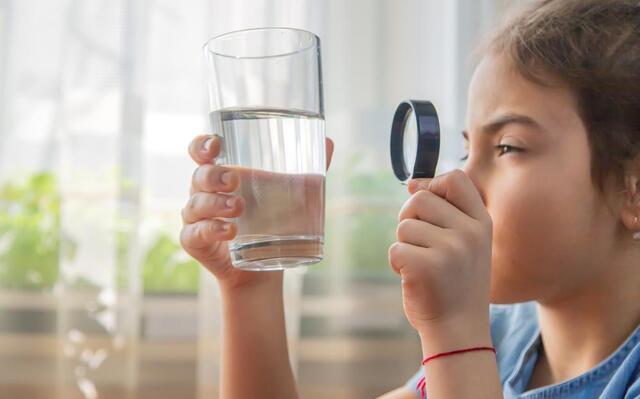PFAS vs. Microplastics: Take Action to Protect Your Water

PFAS and microplastics are two contaminants you don’t want in your water. They’re persistent, widespread and can be linked to health concerns, but they’re not the same. Here’s what you need to know and most importantly, what you can do about it.
Microplastics: The Plastic You Can’t See
What are they?
Microplastics are tiny fragments, smaller than five millimeters, formed when larger plastics break down or are intentionally added to products like cosmetics and cleaners.
What makes them harmful?
Made from polymers like polyethylene and polypropylene, microplastics don’t degrade easily. They can linger in the environment for decades.
Where do they come from?
- Decomposing plastic waste
- Microbeads in personal care items1
- Synthetic fibers from clothing
- Industrial processes
Where do they end up?
They can end up in oceans, rivers, soil and even the air. They travel long distances and often enter the food chain2.
Why should you care?
Microplastics have been detected in human lungs and blood3. Potential risks include:
- Inflammation
- Hormonal disruption
- Chemical exposure from pollutants
Visit the World Health Organizations website to learn more about the potential health impacts from microplastics.
Regulations
Microbeads are banned in many countries, and global efforts aim to reduce plastic waste4. However microplastics still remain a challenge.
PFAS: The Chemicals That Stay Forever
What are they?
PFAS are synthetic chemicals used in water- and grease-resistant products like non-stick cookware, waterproof clothing and food packaging. They’re called “forever chemicals” because they don’t break down easily.
Why so persistent?
PFAS contain carbon-fluorine bonds, among the strongest in chemistry, making them extremely resistant to degradation. Common PFAS include PFOA, PFOS and GenX chemicals1.
Where do they come from?
- Non-stick pans
- Water-repellent fabrics
- Food packaging
- Firefighting foams
- Industrial processes
Where do they go?
PFAS move easily through water, contaminating drinking supplies2 and accumulating in soil and living organisms.
Health concerns:
Exposure has been linked to:
- Higher cholesterol
- Immune system suppression
- Hormonal imbalance
- Increased risk of cancer2
Regulation
The EPA has issued health advisories for PFAS in drinking water2, and some states enforce stricter standards.
Your Action Plan: Reduce PFAS and Microplastics in Your Water
The most effective solution? Water filtration. See the steps below for a great way to get started if you want to add water filtration to your home:
Step 1: Test Your Water
- Schedule a free water test with a local expert. They’ll analyze your tap water and recommend the right system.
- Check your local water report. Public water systems in the United States are required to provide a water quality report. These reports provide a guide on the source and treatment of your water as well as the levels of chemicals or contaminants. Use the EPA’s website to find out more about your water.
Step 2: Install the Right Filter
Before choosing a water filter, it’s important to understand what’s in your water. Whether you’re using city water or a private well, there are filtration options designed to tackle the specific contaminants in your supply.
A quality filtration system can make a big difference, helping reduce harmful substances like lead, chlorine, cysts, PFAS and microplastics. That can mean cleaner, healthier water for you and your family.
Concerned about PFAS or microplastics? Explore the filters below to find the right option for your home.
- HomeShield Whole House Water Filter: Certified to target tough contaminants like PFAS*, with internally validated chlorine reduction — delivering cleaner, healthier water from every tap in your home
- InterFlo IF-14 Water Filter: This under sink water filter reduces over 99% of microplastics, making it a powerful choice for cleaner, safer water
*HomeShield is certified to reduce the following PFAS substances: PFNA, PFOA, PFOS, PFHpA, PFHxS.
Extra Steps to Reduce Exposure
- Switch from single-use plastics to reusable alternatives
- Look for PFAS-free certifications on household items
- Support policies that regulate PFAS and reduce plastic waste
- Share this information, awareness drives change

Bottom Line
PFAS and microplastics may be invisible, but their impact is real. Microplastics come from everyday plastic use, while PFAS can hide in common products. The good news? You can take control, starting with a water test and the right filtration system.
Ready to protect your water? Schedule your free water test today and make the first move toward cleaner, healthier water.
References
- U.S. Environmental Protection Agency (EPA). "PFAS Explained." https://www.epa.gov/pfas/pfas-explained
- EPA. "Drinking Water Health Advisories for PFOA and PFOS." https://www.epa.gov/sdwa/and-polyfluoroalkyl-substances-pfas
- National Institutes of Health (NIH). "Microplastics and Human Health." https://www.ncbi.nlm.nih.gov/pmc/articles/PMC9494273
- UNEP. "Plastic Pollution: Microplastics in the Environment." https://www.unep.org/resources/report/plastic-pollution
- Science Advances. "Detection of Microplastics in Human Blood." https://www.science.org/doi/10.1126/sciadv.abq0850


